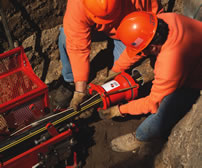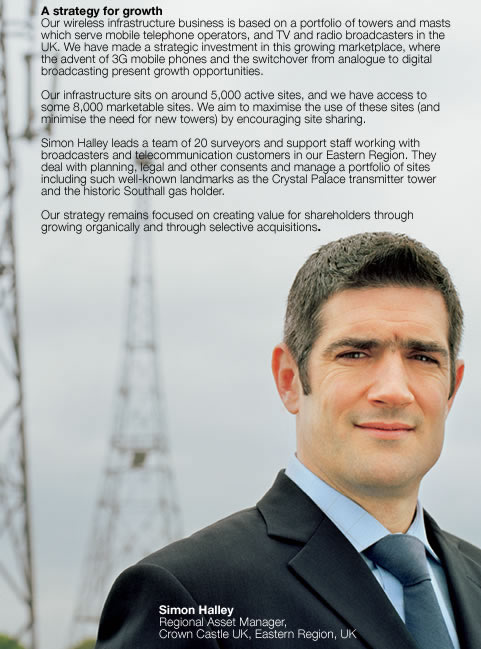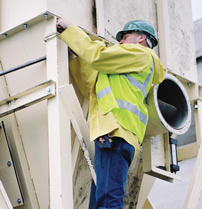
Executive Reports
Our Responsibility for the Environment

- Chairman’s Statement
- Chief Executive’s Review
- Operating Safely
- Operating Performance
- Investing for Growth
- Investing in our People
- Our Responsibility for the Environment
- Our Responsibility to Society

Using a technique pioneered in the UK, our New York business now carries out 'live' gas mains replacement, where the new mains are inserted into the old mains while they continue to operate. We can complete our work more quickly, at a lower cost and with less disruption to our customers and the public.
- Environmental management
- Energy delivery and climate change
- Contaminated land
- Electric and magnetic fields
Environmental management
We have improved our methodology for determining the significance of incidents resulting in the release of methane from our UK gas networks to bring it in line with the approach used for our other significant greenhouse gas, sulphur hexafluoride. As a result, the total number of significant incidents in 2003/04 arising directly from our activities is restated from 46 to 36. For the same reason, the number of significant incidents resulting indirectly from third party damage to our networks, including adverse weather conditions, is restated from 26 to 12. During 2004/05, significant incidents arising directly from our activities and resulting from third party action numbered 22 and 11 respectively.
None of these incidents led to environmental damage that resulted in prosecution by enforcement bodies.
Central to our approach to managing our environmental impacts is the ISO14001 international standard for environmental management systems and the majority of our operations already conform to it. This means that 85% of employees across the Group are now working to a certified environmental management system.
As with safety, our employees have provided valuable feedback on our approach to environmental management with 85% of responses confirming that they feel the Group does act responsibly on environmental issues.

Energy delivery and climate change
In December 2004, we published a Public Position Statement, 'Energy Delivery and Climate Change'. We continue to provide essential infrastructure that will facilitate generators moving to alternative sources of energy, including renewables, with the aim of reducing greenhouse gas emissions.
We have improved the capture of our greenhouse gas emissions by including for the first time in 2004/05, emissions associated with electricity transmission and distribution losses for our New York operations. Our emissions for 2004/05 amounted to some 12.4 million tonnes CO2 equivalent (mte CO2). The graph (left) shows our comparative performance with previous years.
Across our operations, the largest source of greenhouse gas emissions continues to be methane leakage and venting from our UK gas networks, accounting for some 38% of our total emissions. Our long-term programme to replace iron mains with polyethylene pipes will progressively reduce this leakage.
A detailed analysis of our greenhouse gas emissions, including an explanation of the changes, will be available on our website.

We have an active programme for the reclamation and disposal of contaminated former gas works sites for beneficial use. One of the techniques we use is thermal desorption where harmful chemicals are removed from soil by heating in a 'desorber' until the chemicals change into gases. The gases are collected, separated and disposed of safely. The clean soil is returned to the site.
Contaminated land
We continue to manage our portfolio of potentially contaminated sites. They include former manufactured gas plants, industrial landfills, former gas holders and older substations on both our electricity distribution and transmission networks. Sites can sometimes have a complex mix of contamination dating back over 100 years.
In the UK, our remediation programme has its main focus on managing environmental risk followed by the remediation and subsequent development of land for commercial reasons. In the US, in any given year we remediate the sites with highest environmental risk and/or those sites we are required to remediate by regulatory agencies, with the goal of returning these sites to productive public or private use. In 2004/05, we completed remediation projects at 39 locations in the UK and two sites in the US.
Electric and magnetic fields
Electric and magnetic fields (EMFs) are generated from a wide variety of sources, including our power lines and telecommunications infrastructure. While the balance of scientific evidence is against EMFs resulting in adverse health impacts, we recognise that there is some limited scientific evidence suggesting the possibility and that there are parts of society that are concerned about this issue.
In 2003, we took the initiative to improve the dialogue between the various parties with an interest in this issue, by creating a Stakeholder Advisory Group on EMFs (SAGE) with representation from industry, Government, academia, professional bodies and interest groups. As a result of the success of SAGE, the participants have now agreed to establish a more formal Stakeholder Advisory Group under the sponsorship of the Department of Health.


